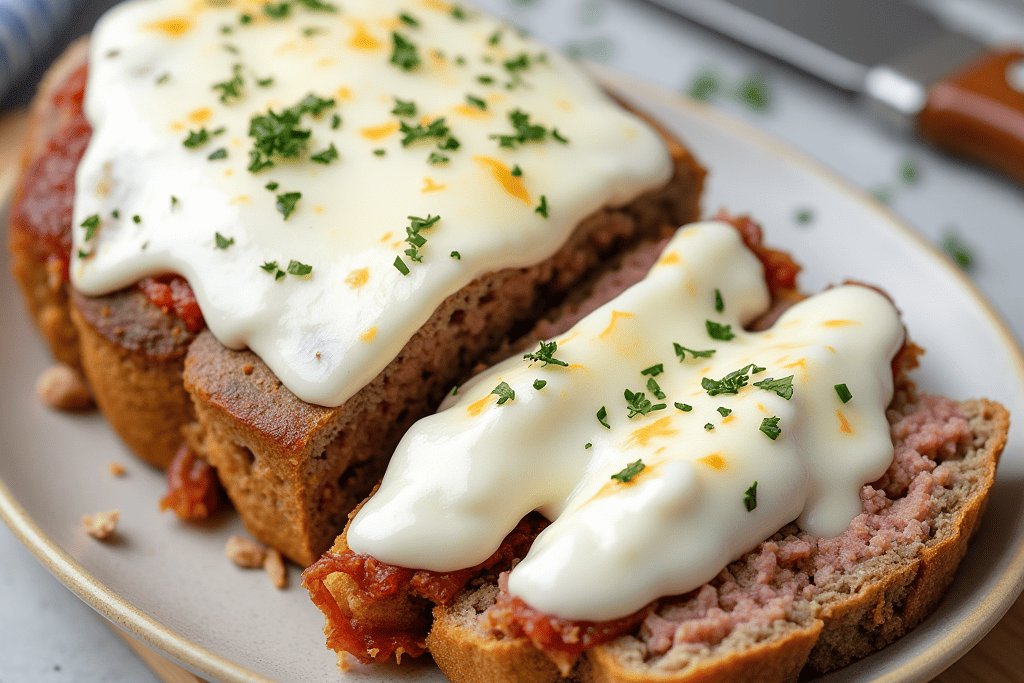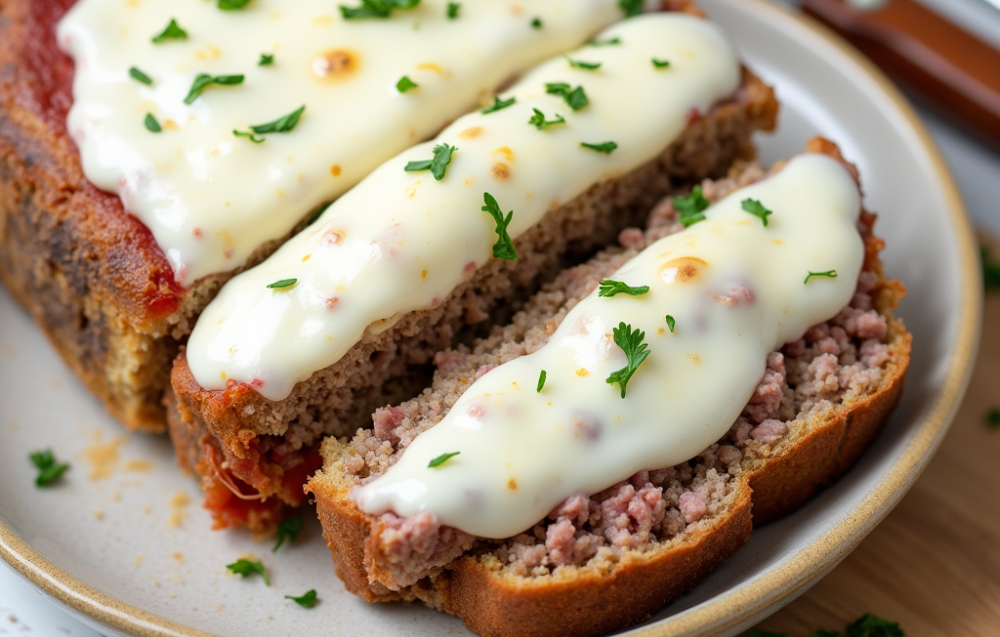Italian Meatloaf is a dish that brings warmth and heartiness to any meal. Whether you’re looking to recreate a family tradition or explore a flavorful new recipe, Italian meatloaf has all the savory ingredients to captivate your taste buds.
But what makes it Italian meatloaf? It’s not just the basic meat mix of ground beef and pork, but a clever incorporation of herbs, garlic, cheeses, and sometimes even a little bit of wine. Add to that the mouth-watering tomato sauce and the rich flavor profile, and you’ve got something that’s truly a twist on the classic meatloaf we all know and love.
If you’ve ever been intimidated by the idea of making meatloaf, fear not! We’re here to guide you step-by-step through the process, sharing the best tips, tricks, and variations that will make your Italian meatloaf irresistible.
Let’s dive in!
What Makes Italian Meatloaf Unique?
If you’re already a fan of classic meatloaf, you might be wondering: “What’s the big deal about Italian meatloaf?” Well, the answer lies in the flavors.
A Blend of Traditional Italian Flavors
Italian cuisine is known for its rich and aromatic flavors, often achieved through the careful use of herbs, garlic, and olive oil. Italian meatloaf, or “polpettone,” takes these familiar elements and combines them with the comforting texture of a classic meatloaf. Think about it—each bite delivers a burst of Mediterranean goodness, featuring:
- Fresh herbs like basil, oregano, and parsley
- Garlic for that earthy, savory punch
- Olive oil to keep things moist
- Parmesan cheese for an added richness
What really makes Italian meatloaf stand out, though, is the tomato sauce that it’s often paired with. Not only does the sauce add an extra layer of flavor, but it also infuses the meatloaf with a juicy, tender texture. Whether you prefer a chunky marinara or a smoother tomato sauce, it’s the perfect finishing touch that sets Italian meatloaf apart from its American counterpart.
Learn more about the classic Italian flavors and how they add richness to everyday meals.

Key Ingredients in Italian Meatloaf
To make the perfect Italian meatloaf, it’s all about using high-quality ingredients and balancing the flavors. While there are countless variations, there are a few core ingredients you’ll find in most Italian meatloaf recipes:
- Ground Meat: Traditional Italian meatloaf uses a mix of beef and pork. The beef provides flavor, while the pork adds tenderness and moisture. Some recipes even include veal for an extra layer of richness.
- Breadcrumbs: To give the meatloaf structure, you’ll need breadcrumbs. But, in Italian cooking, it’s common to use Italian-style breadcrumbs, which are seasoned with herbs and sometimes garlic.
- Eggs: Eggs are used to bind the mixture together and give the meatloaf its firm texture.
- Cheese: A generous amount of grated Parmesan or Pecorino Romano cheese adds both flavor and moisture to the meat.
- Tomato Sauce: No Italian meatloaf is complete without a drizzle of rich, savory tomato sauce on top. It’s not only a garnish; the sauce is part of the overall flavor experience.
- Herbs and Spices: Classic Italian herbs like basil, oregano, and parsley infuse the meatloaf with that unmistakable Italian aroma. You can even add a bit of red pepper flakes for a touch of heat.
With these ingredients in hand, you’re already well on your way to creating a dish that’s both delicious and packed with authentic Italian flavors.
How to Make the Perfect Italian Meatloaf
Making Italian meatloaf is easier than you might think, and with a few simple tips, you can achieve that perfect balance of flavor and texture.
Step-by-Step Recipe for Classic Italian Meatloaf
Ingredients:
- 1 lb ground beef
- 1 lb ground pork
- 1 cup Italian breadcrumbs
- 2 large eggs
- 1 cup grated Parmesan cheese
- 2 cloves garlic, minced
- 2 tablespoons fresh parsley, chopped
- 1 tablespoon fresh basil, chopped
- 1 teaspoon dried oregano
- 1 teaspoon red pepper flakes (optional)
- 1 cup tomato sauce (for topping)
- Olive oil for greasing
Instructions:
- Preheat your oven to 350°F (175°C). Grease a loaf pan with olive oil or line it with parchment paper for easy cleanup.
- Prepare the meat mixture: In a large bowl, combine the ground beef, ground pork, and breadcrumbs. Make sure to break up the meat with your hands to ensure it’s evenly mixed. Add the eggs, grated Parmesan, garlic, parsley, basil, oregano, and red pepper flakes. Season with salt and pepper to taste.
- Mix thoroughly: Using your hands or a spoon, mix all the ingredients together. The mixture should be moist but not too sticky. If it feels too dry, add a splash of milk to help bind it together.
- Shape the meatloaf: Transfer the meat mixture into the prepared loaf pan. Use your hands to shape it into a uniform loaf, pressing it gently into the pan to eliminate any air pockets.
- Bake the meatloaf: Place the loaf pan in the preheated oven and bake for about 45 minutes. The meatloaf should be cooked through, with an internal temperature of around 160°F (71°C). If you like a crispier top, you can broil it for the last few minutes.
- Top with tomato sauce: Once the meatloaf is done baking, remove it from the oven and spread a generous amount of tomato sauce on top. Return it to the oven for an additional 10 minutes to let the sauce meld with the meatloaf.
- Let it rest: After baking, let the meatloaf rest for about 10 minutes before slicing. This helps the juices redistribute, ensuring each slice stays juicy and flavorful.
Tips for Juicy and Flavorful Meatloaf
The key to a great Italian meatloaf is keeping it juicy and tender, not dry and crumbly. Here are some tips to make sure yours turns out perfect every time:
- Use a meat mixture: A combination of beef and pork helps retain moisture and tenderness. You can also add a bit of veal for richness, but be mindful not to overdo it—balance is key.
- Add a binder: Breadcrumbs and eggs are essential to help hold everything together. But you can also add a splash of milk to keep the mixture moist without making it too wet.
- Season well: Don’t skimp on herbs and spices. Fresh parsley, basil, and oregano give the meatloaf that distinct Italian flavor, while garlic adds depth. Be sure to season with salt and pepper, too.
- Cook at the right temperature: Baking your meatloaf at a moderate temperature, around 350°F (175°C), allows the meat to cook through without drying out. If you bake at too high a temperature, the exterior will get too crispy while the inside stays raw.
For an easy and delicious casserole, find out how baking methods can transform simple meals into a perfect family dinner!
Choosing the Right Meat Mix
Choosing the right meat mix is crucial to making a flavorful and juicy Italian meatloaf. The traditional blend of beef and pork gives the meatloaf the perfect balance of flavor and tenderness. You can experiment with different ratios to suit your preferences:
- 70% Beef, 30% Pork: This is a classic ratio that gives you a good balance of beefy flavor and the tenderness of pork.
- 50% Beef, 50% Pork: If you want a meatloaf that’s slightly lighter in flavor but still rich and juicy, this mix works well.
- Adding Veal: Some recipes use a small amount of veal to add richness to the meatloaf. If you choose this option, keep the ratio in mind to avoid overpowering the other flavors.
Discover the best way to make an indulgent dessert like Mounds Cake that can go hand-in-hand with your hearty Italian meatloaf meal.
Incorporating Herbs and Spices
Italian meatloaf shines because of the herbs and spices used in the recipe. While dried oregano is a must, don’t hesitate to experiment with fresh herbs like rosemary or thyme. Just make sure to chop them finely so they can distribute evenly throughout the meatloaf. Fresh garlic also makes a huge difference in flavor.
Explore the different ways to enhance your dishes with flavorful spices by learning how small ingredients can elevate your meals!
Different Variations of Italian Meatloaf
While the classic Italian meatloaf recipe is a crowd-pleaser, it’s always fun to switch things up! Italian cuisine is all about regional variations and creative twists on traditional dishes, and meatloaf is no exception.
Regional Differences in Italian Meatloaf Recipes
Italy is a country known for its diverse culinary traditions, with every region offering its own take on classic recipes. When it comes to meatloaf, you can find subtle differences depending on where in Italy you are.
- Southern Italy: In southern regions like Sicily or Calabria, meatloaf might include a filling of hard-boiled eggs, olives, and capers, reflecting the bold flavors of the Mediterranean. These additions give the meatloaf an extra burst of flavor and texture.
- Northern Italy: In the north, particularly in Lombardy or Piedmont, the meatloaf might include more delicate ingredients such as wine or broth for a richer, more refined flavor. In some areas, they might even add a mix of meats like beef, veal, and pork.
- Tuscany: Known for its love of herbs and olive oil, Tuscan-style meatloaf may include rosemary, thyme, and a hearty drizzle of extra virgin olive oil, giving it a fragrant, savory profile.
Each region’s twist on Italian meatloaf reflects the local ingredients and culinary heritage. So, if you’re feeling adventurous, try exploring different regional versions to experience the full range of flavors!
For more on the diversity of Italian cuisine, check out this informative article on Italian Food Culture and Regional Specialties that covers the uniqueness of food across different Italian regions.
Unique Twists: Adding Cheese, Vegetables, and More
If you love Italian food, you probably already know that cheese and vegetables play a starring role in many recipes. Why not incorporate these into your meatloaf? Here are a few ideas:
- Cheese-stuffed Meatloaf: One of the most popular variations of Italian meatloaf involves stuffing the meatloaf with gooey cheese. Mozzarella is a great choice, but you could also experiment with provolone, ricotta, or fontina for a deliciously melty center.
- Vegetables: Adding finely chopped vegetables, like bell peppers, mushrooms, or spinach, not only enhances the flavor but also makes the meatloaf more nutritious. The vegetables bring moisture and a subtle sweetness to balance the savory meat.
- Meatloaf with Wine: For a richer and more complex flavor, add a splash of red wine to the meat mixture. The wine will infuse the meatloaf with a deep, hearty flavor that complements the herbs and cheese.
Troubleshooting Common Problems with Italian Meatloaf
Even seasoned cooks can run into problems when making meatloaf, especially when you’re trying to get it just right. Fortunately, most issues can be easily fixed. Let’s go over some of the common problems you might face when making Italian meatloaf—and how to solve them.
Why Is Your Italian Meatloaf Dry and How to Fix It?
One of the most common complaints about meatloaf is that it turns out dry. But don’t worry; there are several reasons why this could happen—and solutions to fix it.
Problem: If your meatloaf is dry, it could be due to overcooking, too much lean meat, or not enough moisture in the mixture.
Solution:
- Use a meat blend: As we discussed earlier, the mix of beef and pork is crucial to getting a juicy meatloaf. If you use all lean beef, it may lack the fat needed to keep it moist. Adding pork or veal can help.
- Add moisture: Don’t skip the breadcrumbs and eggs, as these help bind the meat and retain moisture. If the mixture feels too dry, add a bit of milk or even a splash of broth.
- Monitor cooking time: Overcooking is one of the main culprits of dry meatloaf. Use a meat thermometer to make sure it reaches 160°F (71°C) and no more. If you’re concerned about the outside overbaking, cover the meatloaf with foil during the first half of baking to trap moisture.
How to Keep Your Meatloaf from Falling Apart
Nothing’s worse than slicing into a freshly baked meatloaf and watching it fall apart. But don’t worry, this is a fixable problem.
Problem: A meatloaf that falls apart is usually the result of not having enough binder or the wrong meat-to-breadcrumb ratio.
Solution:
- Use the right amount of breadcrumbs: Breadcrumbs act as a binder to hold the meatloaf together. If you don’t use enough, the meatloaf will fall apart. Aim for about 1 cup of breadcrumbs per pound of meat.
- Add eggs: Eggs not only add richness but also help to hold the mixture together. Be sure to use at least one egg per pound of meat.
- Don’t overmix: Overmixing the meatloaf mixture can make it tough. Mix the ingredients until just combined. The less you handle it, the better the texture will be.
Fixing Overcooked or Undercooked Meatloaf
Sometimes, meatloaf can end up either too dry (from overcooking) or too raw (from undercooking). Let’s talk about how to fix both issues.
Problem:
- Overcooked: If your meatloaf is too dry or tough, you may have left it in the oven too long.
- Undercooked: If the inside is still raw or pink, you need to cook it longer.
Solution:
- Use a meat thermometer: A meat thermometer is your best friend when cooking meatloaf. Aim for an internal temperature of 160°F (71°C). If your meatloaf is undercooked, return it to the oven and check again after 10-15 minutes.
- Let it rest: After baking, let the meatloaf rest for 10 minutes before slicing. This helps redistribute the juices and ensures each slice is moist and tender.
Serving Suggestions for Italian Meatloaf
Once your Italian meatloaf is ready, it’s time to serve it up! Italian meatloaf is a versatile dish that pairs beautifully with a variety of sides. Here are some great ideas for serving it:
Traditional Side Dishes to Pair with Italian Meatloaf
Italian meatloaf is hearty and filling, so you’ll want to balance it out with lighter, complementary side dishes. Here are some options that are as comforting as they are flavorful:
- Garlic Bread: A classic choice for Italian meals, garlic bread is perfect for soaking up any extra tomato sauce. It’s crispy, buttery, and absolutely delicious.
- Roasted Vegetables: Roasting vegetables like zucchini, bell peppers, or carrots adds sweetness and depth, which contrasts nicely with the savory meatloaf.
- Mashed Potatoes: A rich, creamy mashed potato side is another great pairing. It complements the meatloaf without overpowering the flavors.
- Salad: A fresh, crisp salad with a tangy vinaigrette can help cut through the richness of the meatloaf. Opt for arugula, spinach, or mixed greens.
Italian Meatloaf Sandwiches: A Delicious Leftover Option
Leftovers? No problem! Italian meatloaf makes an amazing sandwich. Simply slice the meatloaf and place it between two pieces of crusty bread. You can add some fresh mozzarella, a drizzle of olive oil, and a sprinkle of basil for an Italian twist. You’ll love it as much (if not more) the next day!
Nutritional Benefits of Italian Meatloaf
While Italian meatloaf is undeniably delicious, you might be wondering if it’s a healthy option. Let’s take a closer look at the nutritional aspects of this comfort food.
Why Italian Meatloaf Can Be a Healthier Choice
Compared to other meatloaf variations, Italian meatloaf can actually be a bit healthier due to the inclusion of lean meats like pork, the addition of vegetables, and the use of herbs and spices instead of excessive salt or sugar. If you’re conscious about your health, you can also make healthier substitutions, such as:
- Lean meats: Use lean ground beef or turkey for a lower-fat version of Italian meatloaf.
- Whole-grain breadcrumbs: Swap in whole-grain breadcrumbs for added fiber.
- Add vegetables: Throw in some finely chopped spinach, mushrooms, or zucchini for extra nutrients.
Customizing for Dietary Restrictions (Gluten-Free, Keto, etc.)
Many people follow specific dietary plans these days, and thankfully, Italian meatloaf can easily be adapted to suit different needs. For example:
- Gluten-Free: Use gluten-free breadcrumbs or even almond flour as a binder.
- Keto: Opt for ground turkey or chicken, and use cauliflower breadcrumbs for a low-carb option.

